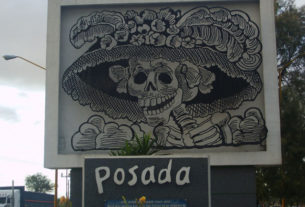Each year, when February is on the horizon, I find myself thinking about the preparation of homemade treats for Valentine’s Day.
Being an incurable romantic, having a wedding anniversary on Valentine’s Day, and living in Mexico, where Valentine motifs are popular not only during this month but throughout the year, all conspire to turn my thoughts to candy, hearts and flowers.
Having written past February columns on Mexican chocolate and sweets, I set about investigating edible flowers and their place in Mexican culinary tradition.
The place to begin, as usual, was with the Spanish chroniclers, who wrote about the incredibly vivid markets that awaited them in the New World. Fascinated by a whole new realm of sights, sounds, flavors and aromas, they dedicated themselves, with a diligence bordering on passion, to describing the wonders of the Mesoamerican food markets, of which flowers were an integral part. “Most gorgeous of all,” writes Jeffrey Pilcher in Food and the Making of Mexican Identity, discussing the first hand descriptions provided by Sahagún and Díaz del Castillo “were the edible flowers of cacao, squash and maguey plants waiting for some shopper to carry them home for soup or tamales.”
The rich ceremonial life of the ancient inhabitants of Mexico required different flowers for each important feast. Cempazuchitl, also known as flor de muertos, marigold, or calendula – now a popular edible north of the border – was the flower that adorned offerings to the spirits of the dead, just as it does today on Día de los Muertos. Along with ornamental blooms, edible flowers occupied their own sections in the ancient marketplaces.
Floral edibles such as jamaica (hibiscus flowers), tila (linden flowers), colorin (coral-tree flowers )and flor de calabaza (squash blossoms) have been, and still are, Mexican market staples and important sources of food and beverages.
Further investigation into Mexico’s edible flowers led me to the evocative reminiscences of Adela Hernandez, daughter of the famous director Emilio Hernandez, one of the greats of Mexico’s Golden Age of Cinema, and himself no slouch in the culinary department. In the introduction to La Traditional Cocina Mexicana y sus Mejores Recetas , Señorita Fernandez described the lavish kitchen in her father’s house in Coyoacan, as well as some of the menus served in that house, including a special dinner consisting of dishes made with flowers.
It seems that the great director – apparently never at a loss for “valentines” of his own – was determined to have the most romantic dinner imaginable for his latest novia, and set about giving directions to his kitchen staff , along with the full-time needleworkers who embroidered napkins and tablecloths for each of his special dinners, for a menu made up of flowers for each course.
Appetizers of tortas de colorín, prepared with the coral tree flowers called lenguas de pájaro – birds’ tongues – by the indigenous people, were followed by squash blossom soup, cress salad, maguey blossom tamales, and agua de jamaica – hibiscus flower water. All of this was served on a tablecloth that had been especially embroidered for the occasion, featuring a design of sunflowers, with stems of fresh sunflowers laid out down the center.
Although most people do not have the household staff required for such elaborate preparations, a course or two featuring edible flowers would certainly be appropriate for a Valentine’s Day dinner. The increasingly large selection of edible flowers in northern markets makes this easier than it would have been even a few years ago. No time to shop? Just get online and order fresh edible flowers, delivered right to your door. Bachelor buttons, squash blossoms, calendula, and several varieties of nasturtiums are only a few of the edible floral options available. To order fresh edible flowers online, check out the Virtual Vegetables website, https://www.virtualvegetables.com. And for lovers of convenience food, Herdez, the brand that distributes canned Mexican salsas, chiles and huitlacoche in both the US and Mexico, now produces canned squash blossoms as well.
Just to get the creative juices flowing, following are traditional Mexican recipes made with edible flowers. Use your imagination, and keep in mind that Mexican food is particularly suited to colorful adornment, and even a sprinkling of mixed petals is a beautiful garnish for soups, salads, and crepes.


